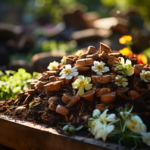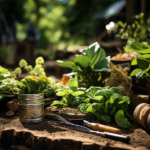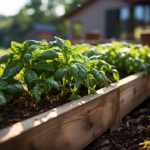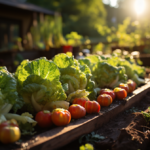Table of Contents
Unearthing Success: Soil Preparation and Its Pivotal Role in Optimizing Your Garden’s Yield
Hey green thumbs! Looking to take your gardening game to the next level? Let me share a little secret with you – it all starts from the ground up (yes, you read that right!). It’s easy to overlook, but the key to a flourishing garden truly lies in its foundation: the soil.
Now, put on your gardening gloves because we’re about to get our hands dirty. In this post, we’re going to delve into the nitty-gritty world of soil preparation. Because, believe it or not, a little pre-planting prep can make all the difference. Whether your garden’s current state is more wild weed-fest than lush Eden, this is where you can truly begin to harness its full potential.
Trust me, excellent soil prep is the MVP of gardening, the unsung hero you didn’t know you needed! It’s the very secret weapon to ensure your plants don’t just survive, but rather thrive! So buckle up, gardeners, it’s time to learn all about maximizing your garden’s potential by mastering the art of soil preparation!
Digging Deeper: Understanding the Significance of Soil Preparation
Grasping the Basics: What is Soil Preparation?
Ever wondered what makes a garden pop with life in all seasons? We have one word for you – Preparation. Soil prep involves revamping and enriching your garden soil before you start planting. Think of it as dressing up your garden for the big dance – creating the perfect environment where plants can strut their stuff!
Earth Science 101: The Composition of Healthy Garden Soil
You might be thinking, it’s just dirt, right? Surprisingly, not all soil is created equal! The soil in your garden is a complex ecosystem. A balanced mix of minerals like sand, silt, clay, and organic matter in your soil affords your plants the best growing conditions.
Getting Down and Dirty: Techniques in Soil Preparation
There’s more to soil prep than just turning the dirt over. We’ll walk you through the different techniques – from basic tillage (good ol’ hoeing and raking) to more intricate methods like double digging, green manuring, and more!
The Circle of Life: Recycling with Composting
Maximizing your garden’s potential also means minimizing waste. Find out the magic of composting and how organic kitchen scraps can be turned into a nutrient-rich feast for your garden.
Prepare to transform your green space into a high-yield, flourishing garden. Stay rooted, and keep reading!
Know Your Soil: Identifying Different Soil Types and Their Characteristics
It’s a Dirty Job: Identifying Different Soil Types
Wait, you’re telling me there’s more than one type of soil? Absolutely! In fact, getting to know your soil type is the first step towards maximizing your garden’s potential. Your plants can be as fussy about the type of soil they like as they are about the amount of sun they get!
- Sand: If your garden soil feels gritty and drains water faster than you can say ‘thirsty’, it’s probably sandy soil. While it’s a dream to work with, you might need to water and feed your plants more often than if you had a different soil type.
- Silt: Silt is smooth to the touch and holds onto water pretty well. Sounds like the perfect soil, right? Watch out though, too much water can compact the soil, making it harder for your plants to spread their roots!
- Clay: Playdough-like clay soil holds onto nutrients but tends to drain poorly. Although it requires a bit more work for proper preparation, when managed right, clay soil can be extremely rewarding.
- Loam: Ah, the creme de la creme of soils! Loamy soil combines the best aspects of sandy, silty, and clay soils. This easy-to-work-with, nutrient-rich soil is the dream for most gardeners out there!
Understanding what types of soil you have in your garden will help you plan accordingly and properly prepare the bed for your plants. So get out there and get your hands dirty!
Digging Deeper: Why Soil Type Matters
Different soils require different preparations so knowing your soil type isn’t just soil science trivia. It’s a fundamental part of enriching your soil and creating the perfect home for your plants.
Green Thumb 101: Essential Tools for Effective Soil Preparation
The Gardener’s Arsenal: Essential Tools for Soil Preparation
Before we plant the first seed or sprout a new seedling, let’s bring out the big guns. They’re the backbone of every garden, the loyal companions in our green-thumbed endeavors. These are the key tools we’ll need to transform our garden’s soil into a plant welcoming party!
- Spades and shovel: Your trusty diggers are the best basic tools for many gardening tasks including soil turning and breaking.
- Garden Hoe: This tool is great for mounding soil and removing weeds. It also helps create neat furrows to tuck your seeds into.
- Garden Fork: For breaking up hard soil, nothing does the job like a sturdy garden fork. It can also help you work organic matter into the soil.
- Rake: A good rake serves double-duty, leveling the soil and gathering any debris like fallen leaves.
- Hand Trowel: Perfect for digging small holes for your plants, hand trowels are invaluable for detail work in your garden.
Remember, every garden tool is as good as the gardener who wields it. So, get comfortable with these tools and they’ll serve you well!
Focus on Quality: Choosing Durable Tools
Here’s a gardening truth bomb: quality tools are worth the investment. Cheap tools may tempt you at the store, but their handles could snap, or their metal parts become dull or rusty all too quickly. Getting quality, durable tools initially could save you money in the long run.
There you have it, all geared up and ready to get that soil in tip-top shape! Soil preparation might be hard work, but remember – it’s also one of the most rewarding stages of gardening. So get ready, set, garden!
Step by Step Guide: The Process of Preparing Your Soil for Planting
The Groundwork: A Step-by-Step Guide to Soil Preparation
Ready to roll up your sleeves and get soil savvy? Great! Here’s a foolproof, garden-approved guide to preparing your soil, ensuring it’s all set and ready to nurture those precious plants of yours.
- Assess Your Soil: Before anything else, figure out whether you’re playing with sandy, clay, silt, or loamy soil. Trust me, this makes a world of difference!
- Clear the Area: Debris, weeds, or rocks? They’ve got to go. You want a nice, clear canvas for your beautiful garden.
- Turn It Over: This is where your trusted spade or garden fork comes in. Turn over your soil to about 12 inches deep, breaking up large clumps.
- Enrich With Compost: Love the environment? So does your garden! Add some compost or organic matter to your soil to dial up its nutrient content.
- Level With a Rake: Now, let’s get your soil bed nice and neat. Level it with a rake and remove any extra debris or stones that might have been missed.
- Let It Rest: Give your soil a chance to chill out and absorb the organic matter. This little breather also allows the soil to settle naturally.
- Test the Soil: Use a soil testing kit to ensure your soil has the correct pH level and nutrients for your plants.
Taking Action: When to Prepare Your Garden Soil
When’s the ideal time to prepare your soil? Typically, early spring or fall, right before you plant new seeds or seedlings. This gives the freshly-prepared soil enough time to settle and lets the nutrients mix in nicely.
So, let’s get out there and cultivate some happy, healthy gardens together. Your green space is about to go from “just ground” to “wow, ground!” in no time!
Common Soil Preparation Pitfalls and How to Avoid Them
Oops…Did I Do That? Common Soil Prep Mistakes
So, you’re all geared up and ready to leap into action, but remember, gardening is a gentle art; it’s not about who digs the fastest or who adds the most compost. Here are some common pitfalls you’ll want to avoid:
- Over-Tilling: Yes, it’s important to turn your soil over and break up the lumps, but be careful not to go overboard. Over-till and you could destroy the structure of your soil or bring up weed seeds that had been happily buried deep down.
- Poor Timing: Steer clear from working your soil when it’s too wet. This can cause compaction and hard clods that are tough to break up.
- Unbalanced Nutrients: More is not always better. While you want to enrich your soil, adding too much fertilizer or compost can throw off the balance of nutrients.
- Ignoring Soil pH: Different plants have different pH preferences. Ignoring the pH level of your soil can lead to less vigorous plants or, worse, plants that won’t grow at all.
Staying Grounded: How to Avoid Gardening Faux Pas
The key to avoiding these garden goofs is knowledge and patience. Understand your soil, give it the TLC it needs, and take your time to do things right. Be patient, as good soil preparation takes time but pays off massively in the long run.
In the end, remember this gardening mantra: Your garden is a living, breathing entity. It doesn’t expect perfection, just your time, care, and understanding. So, stay calm, stay dirty, and keep growing!
Boost Your Garden’s Performance: Soil Enrichment Techniques to Explore
Supercharge Your Soil: Soil Enrichment Techniques You’ve Got to Try
So, we’ve got our soil prepped and ready – but are we done yet? Not quite. It’s time to ACE your gardening game with these supercool soil enrichment techniques to boost your garden’s performance.
- Composting: Think of compost as the soul food of your garden. Made from organic scraps, it’s rich in nutrients, perfect for enhancing soil structure, and provides a slow-release source of nutrients. Plus, it’s great for the environment!
- Green Manuring: This involves growing plants (like legumes) specifically to be turned into the soil. The decomposing plants provide organic matter and nutrients – talk about giving back to nature!
- Crop Rotation: Rotate your crops each season to prevent specific plant diseases and pests from establishing a presence in your soil, while also improving soil fertility.
- Mulching: Got soil moisture evaporation problems? Mulching is your solution! Not only does it keep moisture in, but it also decreases weed growth and adds organic matter as it decomposes.
Digging In: Putting Soil Enrichment Techniques into Action
Intrigued? You should be! Utilizing these techniques will take your garden’s performance to the next level. Start small, perhaps with some homemade compost, and slowly start incorporating the other methods.
Remember, change rarely happens overnight, especially in gardening. But, with perseverance, you can create a powerhouse of a garden one step at a time. So, roll up those sleeves, get your hands dirty (again), and get ready for the garden of your dreams!
Soil Preparation and Seasonality: Timing It Right for Optimal Growth
Timing is Everything: The Role of Seasonality in Soil Preparation
For sure, we’re all pretty excited to jump right into our spring planting when the first warm rays hit our garden, but hold on to your seeds! Understanding the role of seasonality in soil preparation is key for achieving the bountiful garden we all dream of. Let’s dig into this!
Spring into Action: Prepping the Soil in Spring
Spring is the time most gardeners get their hands dirty with soil preparation. As the last of the frost melts away, grab your garden fork and start turning that soil! Remember to enrich it with compost or aged manure for some extra nutrient boost.
Fantastic Fall: Capitalize on Cooler Weather
Fall? But isn’t everything slowing down then? Yes, which is why it’s the perfect time to prepare your soil for the next year! Fall leaves make superb compost material, and cooler weather means fewer pests to worry about.
Winter and Summer: The In-Between Seasons
What about summer and winter? Generally, these aren’t prime soil-prep times. In summer, it’s best to let your garden do its thing, while winter isn’t ideal soil preparation time due to frost and snow.
Taking Mother Nature’s Lead: Aligning Preparation with Nature’s Clock
The takeaway? Aligning your soil preparation with nature’s clock is vital. Why? A well-timed soil preparation schedule not only optimizes growth but also helps avoid common pitfalls, such as soil compaction and nutrient leaching.
Remember, gardening is all about being in sync with Mother Nature. Work with her cycles, and she will shower you with more green goodies than you ever imagined! So, keep your garden gloves close and your garden fork closer, it’s time to unlock your garden’s full potential.
Case Study: The Impact of Proper Soil Preparation on Plant Health
From Theory to Reality: A Case Study on Soil Preparation & Plant Health
Alright, it’s story time! Let’s leave the lists and guides for a moment and dive into a real-life gardening journey. This tale is about Jane, a determined gardener, and the lessons she learned about soil preparation.
The Gardener’s Tale: Jane’s Journey
Jane was an avid gardener. Yet, despite her efforts, her tomato plants always seemed a tad underwhelmed. She watered them diligently, placed them in the sunniest spot, yet somehow, the plants lacked vigor, and the tomato yield was less than spectacular. Then, Jane learned about the role of proper soil preparation.
She found out her garden had heavy clay soil which was starved of organic matter and was pretty compacted, which inhibited root growth. The light bulb moment came when she realized she had been overlooking this crucial aspect of gardening.
So, the following season, Jane decided to get soil savvy. She added compost to the clay soil, tilled it, and let it rest. Over the season, she noticed revolutionary changes. The tomato plants seemed happier, healthier, and oh boy, the yield was something she had only dreamt of!
The Moral of the Story: Soil Preparation is Key
Jane’s story spells out the difference proper soil preparation can make to plant health and yield. From wilted plants and few tomatoes to lush green foliage and abundant fruits, the transformation was amazing.
By putting her shovel to work and investing time in soil preparation, Jane’s gardening game changed forever! So, fellow gardeners, the proof is in the (tomato) pudding! If you provide your plants with a well-prepared, nutrient-rich home, they’ll reward you with health and an impressive harvest. Ready to follow Jane’s footsteps? Your garden is waiting!
Your Questions Answered: FAQ about Soil Preparation and Garden Maximization
Digging Into Your Queries: Soil Prep FAQ
Got questions about soil prep? You’re not alone! It’s a big, wide, garden world out there. So, let’s fill in some of the blanks with answers to commonly asked questions:
Q: How often should I prepare my soil?
A: Typically, you’ll want to give your soil a good prep before each main planting season, usually in early spring or fall. Remember, it also depends on the crop you’re planning to grow, as different plants have different soil needs.
Q: Should I always add compost to my soil?
A: Composting is a great way to naturally enrich your soil. However, be prudent. Applying too much compost can lead to nutrient imbalances. Generally, a layer of about 2-3 inches of compost yearly should do the trick.
Q: Do I need to test my soil?
A: It’s not mandatory, but testing your soil pH and nutrient levels can provide useful info on what your soil might be lacking. It helps in tailoring your preparation process to create the perfect environment for your plants.
Q: What’s the best way to break up compacted soil?
A: If your soil is compacted, introducing organic matter like compost or well-rotted manure can help. Additionally, physical aeration, using a garden fork to make holes in the soil, can induce porosity.
Q: Can I prepare my soil for specific plants?
A: Absolutely! Some plants prefer acidic soil, while others thrive in alkaline soil. Research on your plants’ preferences and prepare your soil accordingly.
In the end, remember, there’s no such thing as a green thumb. It’s about understanding your garden, your soil, and your plants. Arm yourself with these nuggets of knowledge, and you’ll be set on the path to gardening glory! So, keep asking, keep learning, and most importantly, keep gardening!
Conclusion
And there you have it, green thumbs! We’ve journeyed through the depths of soil preparation and emerged, hands dirt-filled and minds grown with newfound knowledge. Remember, the journey to a blossoming garden begins beneath the surface. Mastering the art of soil preparation is your not-so-secret weapon towards maximizing your garden’s potential.
Like a symphony, every component in your gardening practice plays a significant role, but prepping your soil is the conductor – setting the rhythm and guiding the performance. It’s an element that ties everything together, creating harmony between the soil, plants, and even the garden-dwelling critters.
Don’t take soil preparation lightly. Treat it like the transformative garden practice it is! Because from composting to learning how to dance with the seasons, the lessons you learn will not only impact your plants’ health and growth but also foster a deeper understanding and respect for nature’s processes.
Take this knowledge, and prepare to dive, hands plunged into the soil, into the wonderful world of gardening. By enriching your soil, you’ll create a green oasis that is not only vibrant and bountiful but also a sustainable, living testament to your garden’s unlocked potential. So, happy gardening, my friends! Let’s get those gardens flourishing!









